Wednesday, 17 September, 2014. 20:05
We are sitting down to dinner with Maria, Terry, Zi, Jay, Jill, and Leanne, in the hotel restaurant. They have a limited choice of dishes, which changes each night. We can have pastillas like last night, or tajines with either chicken, meat (lamb or beef – it’s not clear), or vegetable. They come in a fixed menu with Moroccan soup and a dessert, or separately. We asked what the soup was, and the waiter said it contained tomato, rice, and “chicken pieces”. We asked if they had a vegetarian soup, and he said it only contained vegetables. We were all confused as he rattled of the ingredients again: tomato, rice, chicken pieces… We stopped him and said chicken isn’t a vegetable, and he said it, “Not chicken, chicken pieces…” Then he gestured that it was small balls, a type of vegetable, and we realised it was chick peas!
We got up this morning and had a leisurely preparation for breakfast, doing some stretching exercises to get the knots out of our muscles. The breakfast downstairs in the courtyard included yoghurt, freshly squeezed orange juice, boiled eggs, and a selection of breads and pastries. The eggs were so hot it was difficult to peel them, but they went well with the bread. There was a warm flatbread which was like a roti, and delicious. The “pepper” in the pinch tray with the salt turned out to be some sort of curry powder, not pepper. The breakfast service was leisurely, and we only had about ten minutes afterwards before the tour meeting at 09:00.
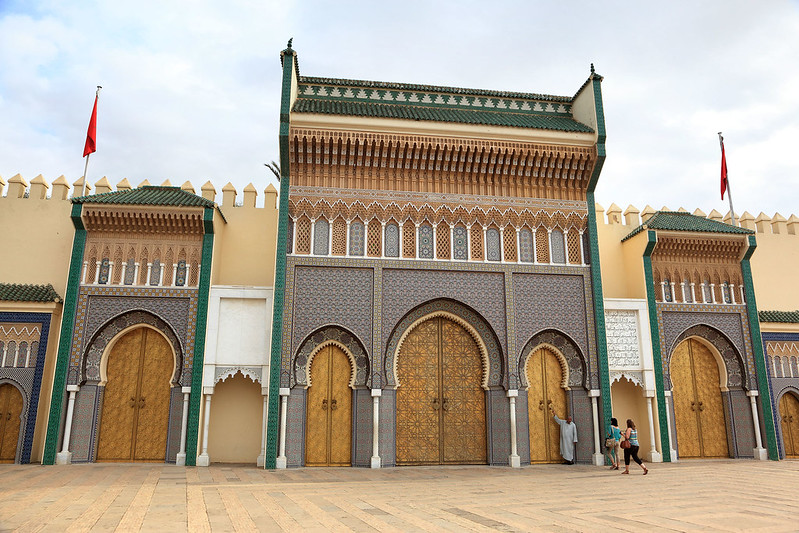 Gates of the Royal Palace of Fes. |
We met our local guide for the day, a woman named Hakima. She and Lahcen led us out of the medina from our hotel to the bus and we took a short drive through Fes to the front doors of the royal palace. This was a series of seven brass-clad cedar doors of various sizes set into arches, seven being a lucky number. Inside the palace there are apparently seven floors, seven this, seven that, and so on. But we couldn’t go in, and the palace was never open to visitors. Hakima explained about the decorations on and around the doors and told us lots about the history of the palace and the king.
From there she led us down a street which was lined with two storey buildings with shops at street level and homes above. They had interesting balconies and shuttered windows. Hakima explained that this was a Jewish area, the Mellah, and the balconies are peculiar to Jewish buildings, as Muslims didn’t have balconies on their houses, just windows. She stopped us at a shop to explain about the spices and henna and other stuff they were selling. One of the products was a black, thick, greasy looking substance, which we looked at curiously. Hakima asked us to guess what it was, and answers came back of various things including axle grease, but nobody got the right answer, which was soap! It was made from olives.
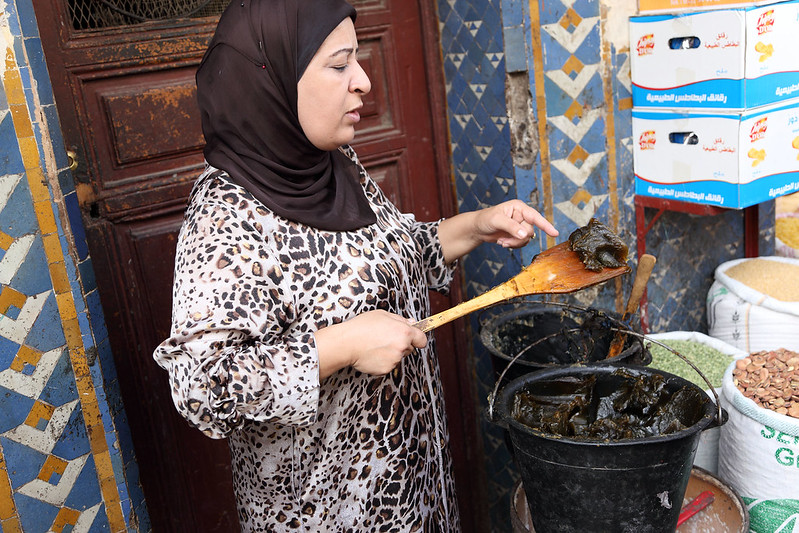 Hakima showing us black soap in the Mellah. |
At the end of the street we rejoined the bus for a trip to the top of a hill which overlooked the medina, so we could get a panoramic view of just how big it was. Lahcen and Hakima had briefed us on safety when we went into the medina. We were to stay within sight of each other, and if we got separated we were to stay put, so a guide could retrace the route and find us. And we needed to wear our packs on our fronts and be aware of pickpockets, and not speak to anyone who approached us trying to sell us anything. The lookout spot gave us a spectacular view over the valley in which the medina sprawled.
 The Medina of Fes. |
Done there, we moved in the bus to the Art Naji ceramics workshop, where we had a tour of the production facilities and got to see how they made various ceramics, including tajines, pots, bowls, and so on, and ceramic tiles, with which they made mosaics. We saw men spinning clay into bowls and tajines, and then saw the kilns. A man was sitting at a foot-operated pottery wheel, spinning a huge lump of grey clay and drawing up enough to form a bowl for the bottom of a tajine. He made the shape entirely by hand, with no moulds or guides, and then used a string to cut it off. He placed the bowl on a tray where there was space for six bowls, and started drawing up clay to make another one. By the time the guide from the ceramic works had explained what he was doing, he’d made three bowls! I asked how many one person could make in a day, and the guy said about a hundred.
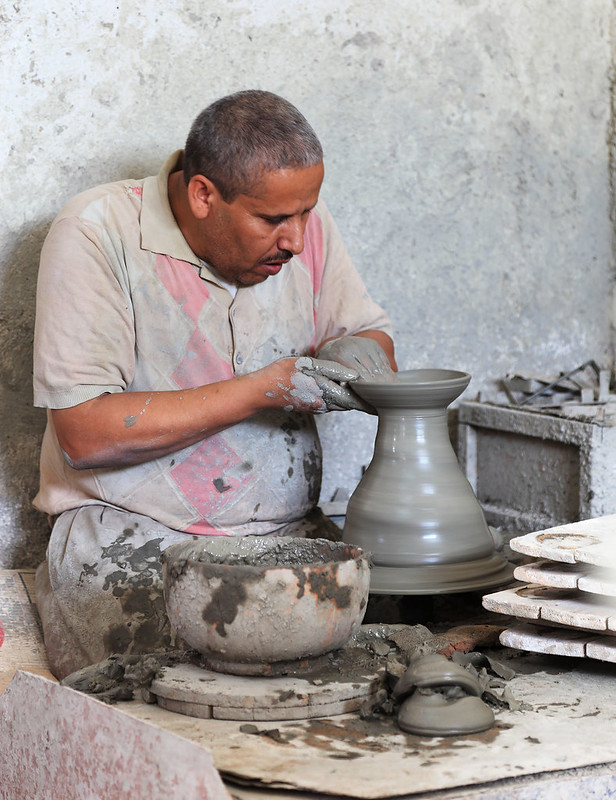 Potter at Art Naji. |
Next we saw a room where men and women were painting designs onto unfired pottery, again all by hand. Many of them were being painted with a purple glaze, which turned a deep blue when fired, this being the traditional colour of Fes. Others were working with a dozen or so colours. Purple is the the only colour which changes colour when it is fired for some reason.
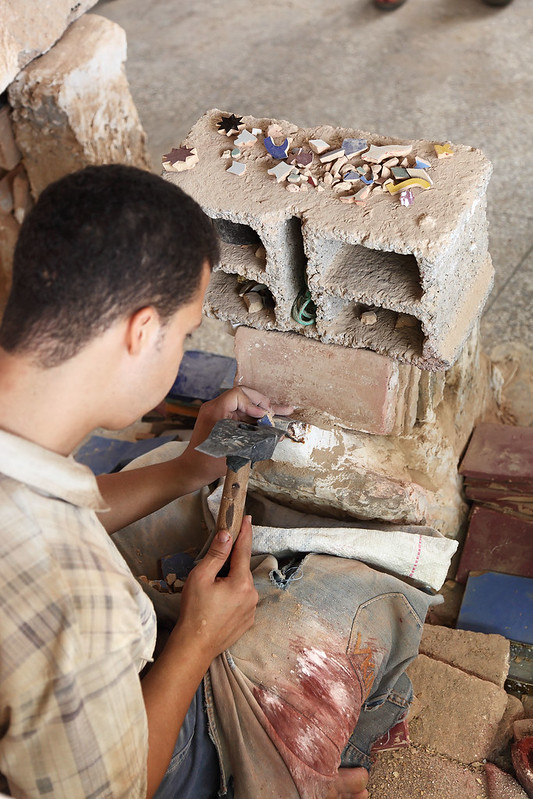 Tile chipper. |
Then we moved on to the area where they made mosaic tiles and assembled mosaics. This was astonishing. The mosaics are made of tiny tiles, about a centimetre across, in various geometrical shapes which are assembled in various colours to make the intricate patterns. But they don’t make the tiles in those shapes. They make big square tiles, about 15 cm across, and then men sit at a tiny anvil with a tiny sharp edged hammer and chip the tiles into the required shapes and sizes by hand, without measuring them or tracing a shape pattern onto them. They make all sorts of shapes, including tiny six pointed stars of David, and other shapes with precise 60° and other angles required for mosaicing. A man cut out a six-pointed star from a larger chunk of tile as we watched, judging it all by eye, the size and the angles. He did it in about a minute, the went on and made more of them.
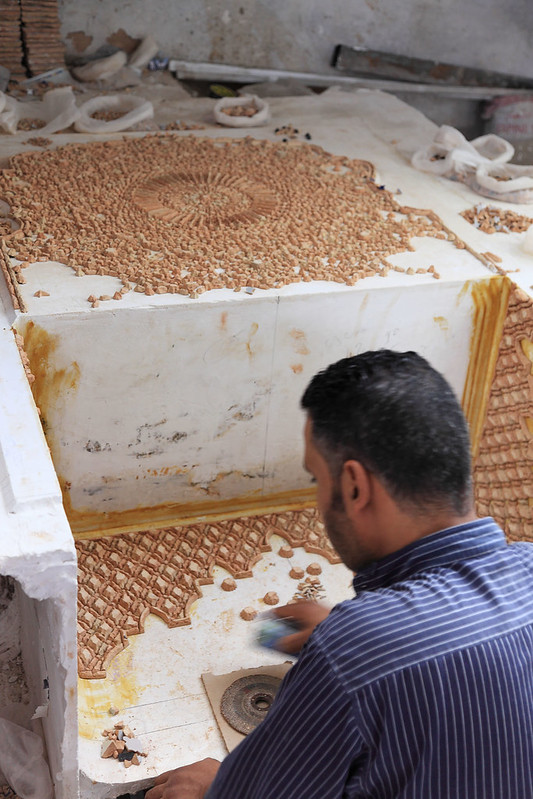 Mosaic maker. |
And the next incredible thing was how they assembled these tiles into mosaics. You would think they’d stick the backs of the tiles onto a surface, so they could see the pattern evolve as they worked. No. They set up a formwork frame, then lay the tiles face down in the frame, with no binder at all, so the coloured surface is hidden from view. They work on filling in the design by memory of what colour tiles they have already used where, the whole time seeing nothing but the uniform grey backs of all the tiles laid loose in the formwork. Then when it’s finished, they pour concrete over the backs of all the tiles in the formwork to bind them together, and finally lift the finished mosaic up off the floor, to reveal the design for the first time. Someone asked the guide if they ever make a mistake, and he said yes, definitely. After the work is revealed, sometimes there is a wrong coloured tile somewhere. They can chip it out and replace it if it’s too obvious, or sometimes they might just leave it there. Besides flat mosaic done simply on the floor, they also have curved moulds for making fountains and basins, which are filled the same way with tiles face down, held with a temporary glue for areas of the mould where loose tiles would fall down. The result of all this work was astonishing.
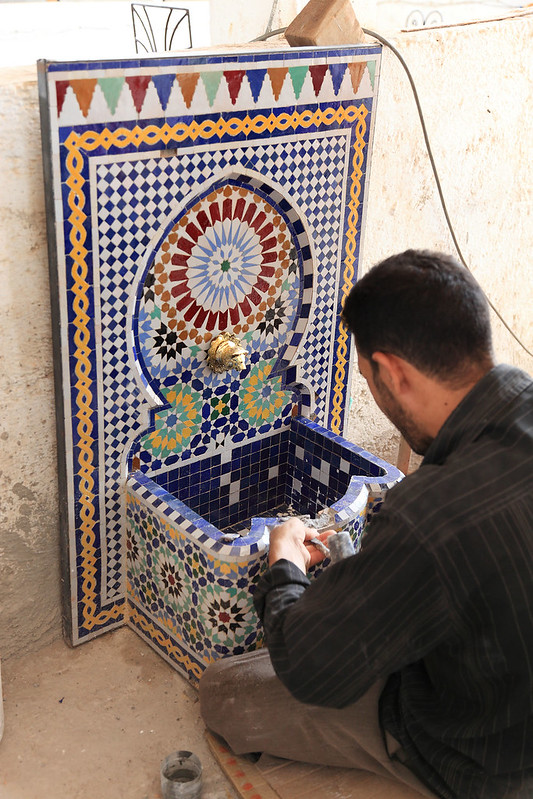 Mosaic fixer. |
Finally the guide led us to the shop, where several of us on the tour bought items, ranging from tajines to bowls and plates, all marked with a label indicating they had been made in Fes. We bought a small tajine for my mum, and a couple of small bowls for ourselves. I suggested we should have them shipped home, and we had another tajine for M.’s mum originally, but the guy said the total was too small to be worth shipping, and quoted a shipping fee of 1200 dirhams, which was about five times the price of the items. So we ditched a tajine and decided we’d have to carry the rest home.
Back in the bus, we headed to the old medina. We got off the bus in a parking area and headed on foot into the medina. But first we stopped to get some prickly pear fruit, which was delicious and sweet. It cost just 1 dirham a piece, and the seller peeled the fruit for us with a knife. Then it was into the medina. This was a real experience! The alleyways were incredibly narrow, and we had to walk in single file sometimes just to get through the gaps between the buildings. At other times the alleys were wide enough to walk maybe three or four abreast, but we needed to stick to single or double file to allow space for others to walk the other way, including donkeys laden with goods and men pulling or pushing two-wheeled carts full of stuff. Hakima had told us that the one word of Arabic we had to know was “balak“, which means “look out”. Men with trolleys and donkey drivers would yell this out (“Balak! Balak!“) and we had to clear a path for them quickly, because they moved fast and were impatient if you got in the way.
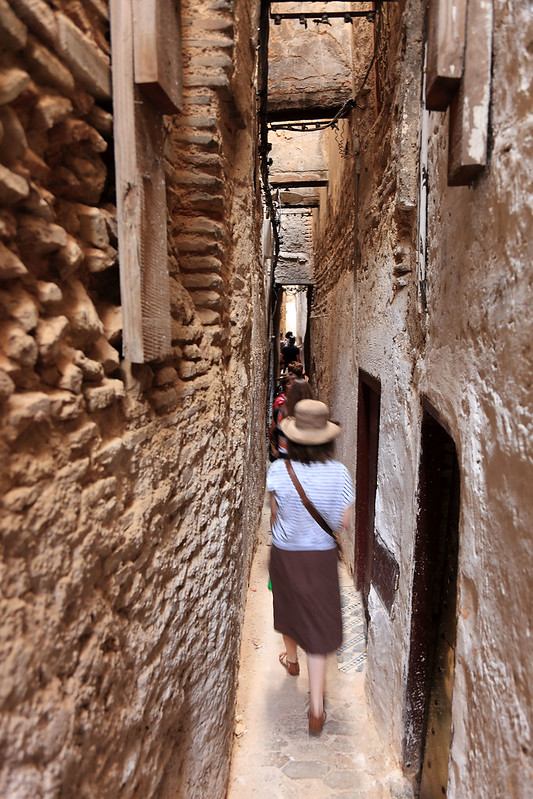 Street in the medina. |
The paths were crowded with people: men, women, and children of all ages. We got harassed by people trying to sell us stuff or children begging for money a little bit, but not as much as we were expecting. I think because they saw we were with guides and in an organised group we were targeted less. But we often passed other obvious tourists who were on their own and trying to find their way around the impossible maze. Just before the lunch stop we saw a young European couple with two strollers with infants in them, stopped and looking with puzzlement at a map. We all just boggled and couldn’t believe they were trying to find their way around by themselves.
 A wider street in the medina, lined with market stalls. |
We passed an astonishing variety of different areas and things in a short space of time. Some places were just single-file narrow passages between blanks walls of residences, punctuated by doors and balconies overhead enclosing the space into almost a tunnel. Other areas were bustling marketplaces with stalls lining both sides of the passage, wide enough to walk perhaps three abreast, so allowing the non-stop traffic of people to flow in both directions. We passed places selling fresh fruit and meat and fish – all of which must presumably be carried in to the medina on a daily basis from outside. There were craftsmen and artisans and others doing their jobs in the narrow streets. We passed a couple of men dying huge bundles of thread, splashing the dye messily all over the street as we walked past. In other places newly made or washed or dyed clothes were strung up over the streets to dry.
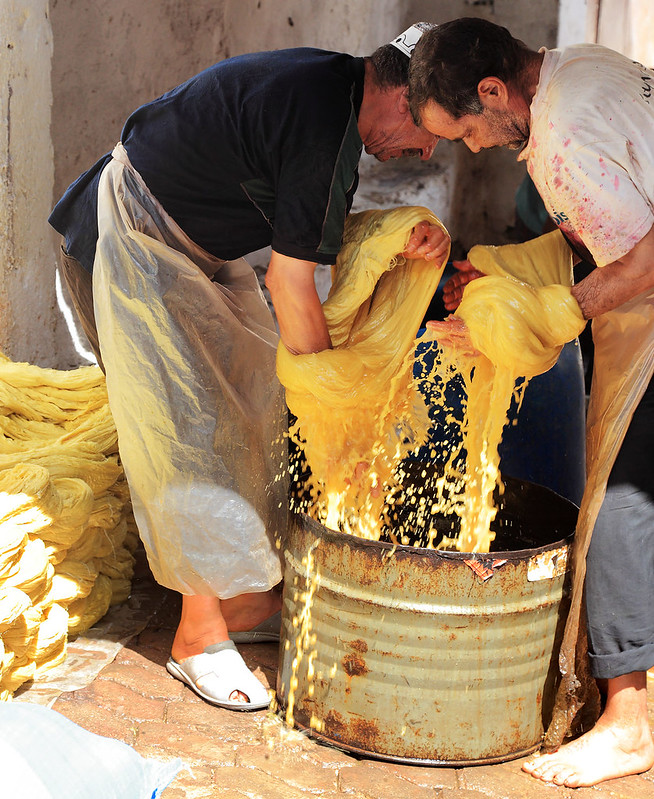 Men dying thread in the street. |
The first place that we paused at long enough to call it a stop was a leather shop, which was inside a building up a very steep and narrow square spiral staircase. One floor was full of jackets, and up another flight of stairs was a top floor full of bags and shoes. This floor had a balcony which overlooked the famous tanning and dying pits of Fes below. The smell coming from the pits below was unpleasant, as they use urine and bird droppings for the process, and shop staff handed out fresh mint leaves for people to sniff to alleviate the odour. I didn’t think it was quite that bad, but some others seemed to be affected by it. We spent some time at this place, as several people wanted to buy things. M. got a blue leather bag, bargaining the man down from 650 to 450 dirhams. Jill wanted a leather jacket but they didn’t have the exact size and colour she wanted, so the shop guy said to give him her hotel name and he would deliver a handmade jacket to order for her later in the evening! He said it would take just three hours and he’d bring her jacket to the hotel at 19:30, and later he arrived bang on time with the jacket for Jill, made from scratch during the afternoon!
 Leather tanning and dying pits. |
Eventually we left and quickly went to the old Koranic school of al-Qarawiyyin, which is the oldest university in the world, predating even Oxford and the Sorbonne. People were just leaving and Hakima told us to take pictures through the entrance doors quickly before they closed them for the afternoon break.
From there we went to Le Patio Bleu, a small riad which had been converted into a restaurant. As we arrived the staff used silver shakers to sprinkle perfumed rose water on our hands to clean and refresh them. The lunch was a fixed menu of Moroccan salad, followed by chicken, beef, lamb, or vegetable tajines with various options, and then fruit. The “salad” turned out to be tapas-like plates of various vegetable concoctions, including: an eggplant dip like baba ganoush, a cauliflower thing, potatoes with mushrooms, potatoes and sweet potatoes, olives marinated in something that made them sweet, a spicy mix of red and green peppers, and carrots. There was also a thick lentil soup, although there was no bowls or spoons to eat it with – we scooped it onto our plates and ate it with a fork or by dipping bread into it. These were served with bread and were all really tasty. We could have had just this for lunch, but had to leave room for the tajines! I had the lamb with apricots and prunes, which was amazingly good, the meat just flaking apart at the touch of a fork. The fruit for dessert was pomegranate, plums, and large red grapes.
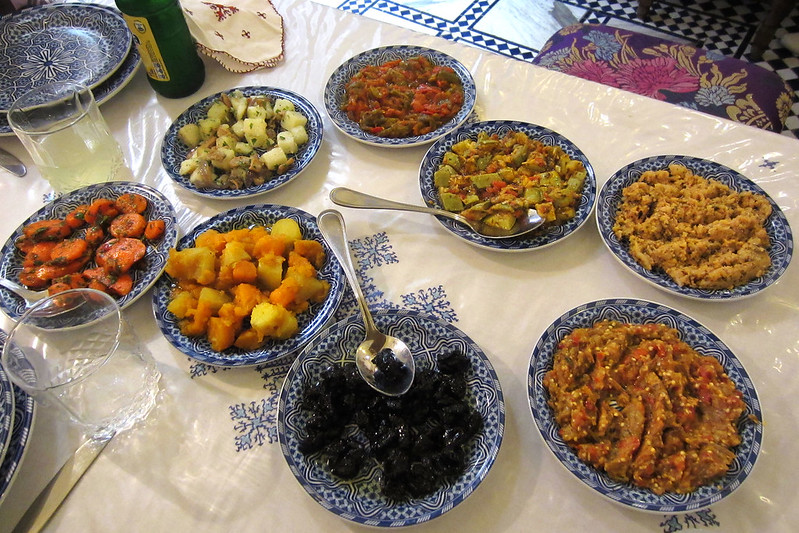 Moroccan salad at Le Patio Bleu restaurant. |
Then we stopped in a shop where they made metalwork, including impressively decorated brass plates, silver teapots, and various other things. Again we got a demo of an artisan making one of the pieces, in this case a brass plate. He punched a design into the metal using a simple chisel edge and hammer, with no stencil or marking, making the entire design from his head as he went. This was followed by another chance to buy stuff. Anna was the first taker here, going for a silver perfume shaker, like the ones which the restaurant staff had used to sprinkle us with rose water when we arrived for lunch. She leapt to be first buyer because the guy said there was a free gift for whoever bought something first. This turned out to be a silver Hand of Fatima keyring. We later found out Terry had also bought a silver teapot.
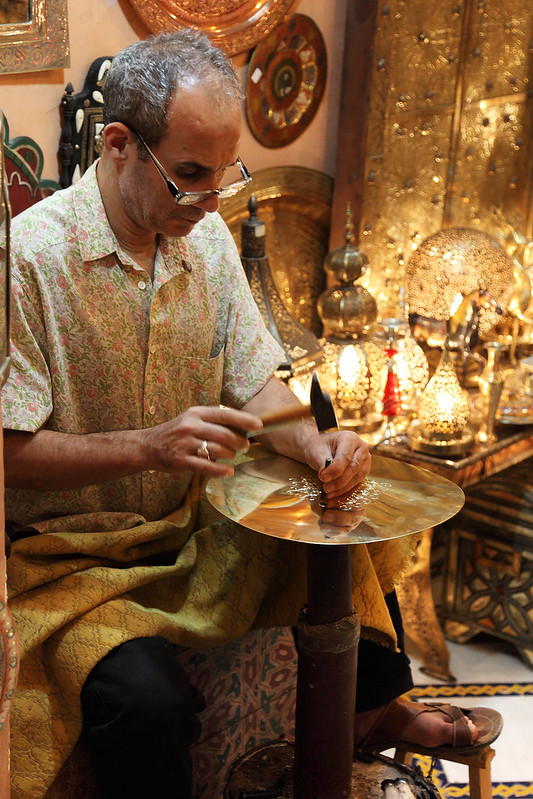 Metalworker working on a brass plate. |
We went to the Nejjarine Museum of Wooden Arts and Crafts, which had three floors of displays for various woodworking tools, plus the items made using them. Much of it was cedar wood, and items including furniture, decorated ornate window shutters, doors, shelves, chests, and so on. There was a terrace on the roof, which gave a chance for a photo from above and within the medina. Outside is the famous Nejjarine Fountain, which is a beautiful mosaic tiled fountain, but not very large.
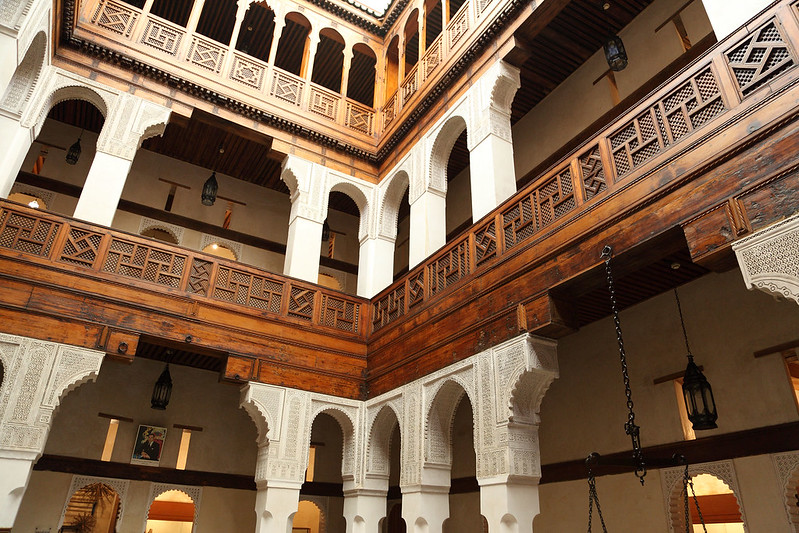 Nejjarine Museum of Wooden Arts & Crafts. |
Some of the areas of the medina were very squalid and dirty. But now we walked through an area where the artisans made bridal chairs, which were amazing pieces of work, decorated entirely in white and spangled with huge amounts of fancy materials. There were dozens of small workshops in one tiny alley dedicated to making just these by the looks of them. Some chairs were huge and designed for sitting in at a reception, while others were in sedan chairs for carrying the bride and groom around.
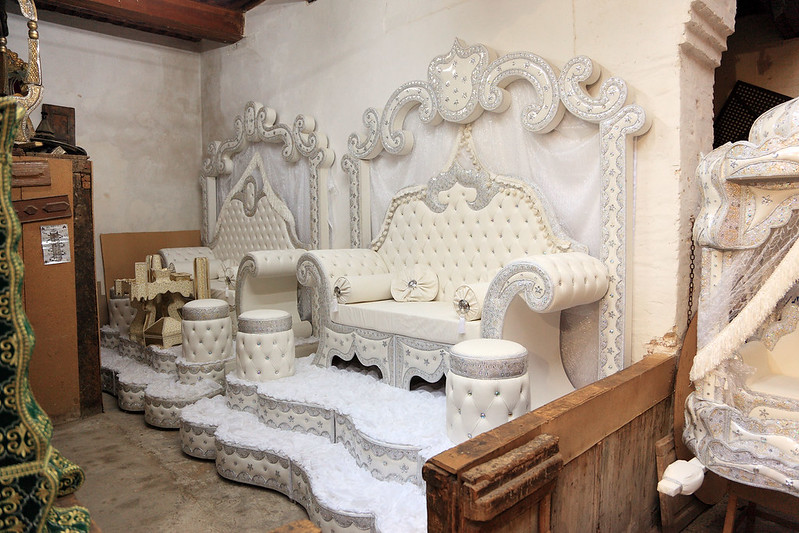 Wedding seats. |
Next we stopped at the Al-Attarine Madrasa, built originally in 1323. It has been restored and now serves as a museum-like display. It was amazing, with incredibly intricate plasterwork, cedar wood carvings, and mosaic tilework. Hakima explained that the plaster was a mixture of ground marble, plaster, and egg white. Which was carved while wet into the amazing shapes we saw, which included geometrical designs and Koran verses. The madrasa was a beautiful and very peaceful place amid the hustle and bustle and chaos of the medina outside.
 Al-Attarine Madrasa. |
Back out in the alleys of the medina, we stopped outside a public bakery. Hakima explained that people brought their bread dough here to be baked, and as she was talking a small boy, about six years old, walked past with a tray of unbaked loaves on his head, and took them into the bakery. She said usually the children bring the bread to be baked. Someone asked if they cooked anything else in the bakery, and Hakima said yes, you could prepare a tajine at home and bring it to the bakery to be cooked, then take it home to eat. She said you could cook food at home, but it tasted better if you brought it to the bakery to be cooked there. This was because it was a wood fired oven.
The final stop in the medina was a fabric workshop where weavers used foot powered looms to weave amazing cloth out of cactus silk from agave cacti, or Egyptian cotton, or wool. The colours were amazing, and we bought a Fes blue tablecloth of cactus silk, and some scarves for M. As part of the explanation and demonstration by the owner, he wrapped colourful scarves around the heads of me and Anna in Berber fashion. (A few days later, when we had to wrap scarves around our heads in the Sahara Desert, Maria managed to do it perfectly, saying she knew how because she had watched this demonstration carefully.)
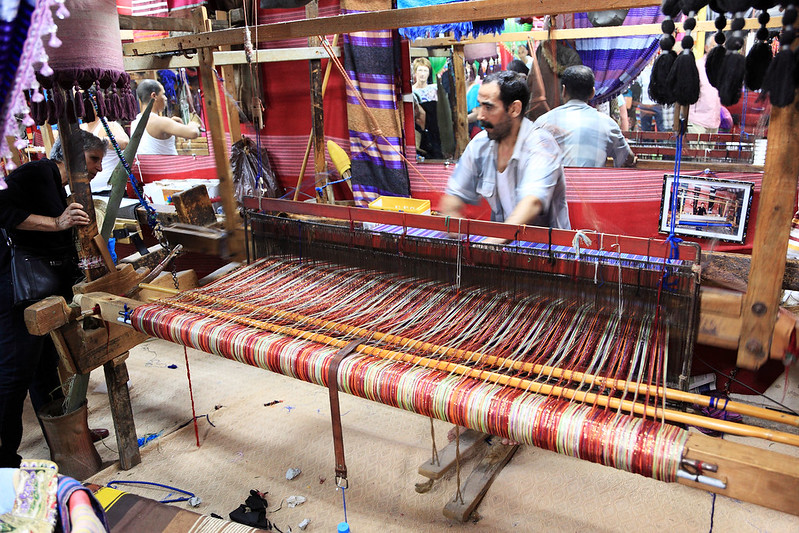 Weaver at work. |
Hakima led us through more of the twisty alleys of the medina, then turned a completely nondescript corner, and hey presto, we were out of it and back in the large car park where our bus awaited. Suddenly we were in sunlight again, which had been scarce in the deep narrow clefts of the medina. It was like emerging from twilight into full daylight.
The bus drove us back to our riad, where most of the group decided to stay in and eat in the hotel restaurant again. A few adventurous souls wanted to go somewhere else. Before dinner we went up on the roof terrace to look at the view over the medina. We decided to go back up around 19:00 to catch the last rays of sunset on the medina for a photo. When we got there I thought we’d missed it, but then the sun emerged from behind some low cloud on the western horizon and gave the medina a magical glow, making the chaos look pretty. M. and I stayed in the hotel restaurant and got a half bottle of a local rosé wine from Meknes, which was dry and very acceptable. Then we ate dinner, M. picking just the “traditional Moroccan” soup, while I had just the chicken tajine, which was made with olives and preserved lemon. It was nice, and I stole some of the honey cakes and dates from the soup as a sort of dessert.
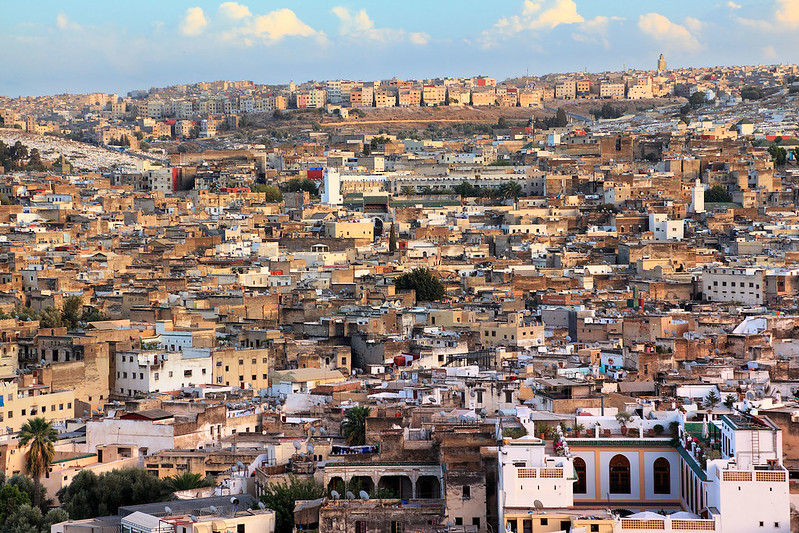 The medina rooftops at sunset. |
The final act of the day was to return to the roof for some night shots of the medina using my tripod. That done, we showered and went to bed, after an extremely full day.
